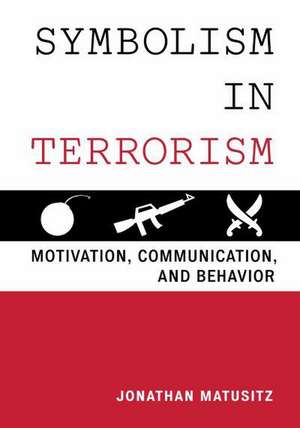Symbolism in Terrorism
Autor Jonathan Matusitzen Limba Engleză Hardback – 16 sep 2014
| Toate formatele și edițiile | Preț | Express |
|---|---|---|
| Paperback (1) | 526.95 lei 6-8 săpt. | |
| Rowman & Littlefield – 16 sep 2014 | 526.95 lei 6-8 săpt. | |
| Hardback (1) | 745.51 lei 6-8 săpt. | |
| Rowman & Littlefield – 16 sep 2014 | 745.51 lei 6-8 săpt. |
Preț: 745.51 lei
Preț vechi: 1021.25 lei
-27% Nou
Puncte Express: 1118
Preț estimativ în valută:
142.69€ • 147.05$ • 120.47£
142.69€ • 147.05$ • 120.47£
Carte tipărită la comandă
Livrare economică 03-17 martie
Preluare comenzi: 021 569.72.76
Specificații
ISBN-13: 9781442235779
ISBN-10: 1442235772
Pagini: 339
Ilustrații: 2 black & white illustrations, 7 black & white halftones
Dimensiuni: 178 x 254 x 25 mm
Greutate: 0.82 kg
Editura: Rowman & Littlefield
ISBN-10: 1442235772
Pagini: 339
Ilustrații: 2 black & white illustrations, 7 black & white halftones
Dimensiuni: 178 x 254 x 25 mm
Greutate: 0.82 kg
Editura: Rowman & Littlefield
Notă biografică
Descriere
The symbolic character of terrorism is the focus of this textbook. A comprehensive analysis, it incorporates descriptions, definitions, case studies, and theories. This groundbreaking text encompasses all major aspects of symbolism in terrorism and will be an essential resource for anyone studying the subject.
Cuprins
Introduction
1. What Is Symbolism?
Symbol: Origin of the Word
Symbolism: General Description
Anthroposemiosis
Meaning-Making
Symbol vs. Sign
Three Categories of Symbols
Physical Symbols
Nonphysical Symbols
Summary
2. Interpreting Symbolism in Terrorism: A First Step
Definition of Terrorism
Defining Terrorism with Symbolic Elements
Terrorism as Performative Violence
Terrorism as a Transnational Injustice Symbol
Linguistic Symbolism in Terrorism: Irish and Arabic
Linguistic Symbolism in Terrorism: Name-Giving Codes
Terror Glorification: Symbolic Palestinian Terrorists
Terror Glorification: Symbolic Timing
September 11, 1565, September 11, 1683, and September 11, 1697
April 19, 1993
Summary
3. Symbolic Targets
Targets of Terrorism
Impact on the Audience
Attacking Sacred Symbols: Iconoclasm
Clash of Civilizations
The World Trade Center as a Symbolic Target
Blowback Theory
Liquid Modernity
Westoxification
Anti-Globalization
Anti-Multiculturalism
Summary
4. The Symbolic Culture of Terrorism
Culture: Definition
Symbolic Interactionism
Organizational Culture
Positive Cult vs. Negative Cult
Ritual
Ritual Terrorism
Honor Killing
Summary
5. Myth in Symbolic Terrorism
Myth: Description
Symbolic DNA of Terrorism
Symbolic Convergence Theory (SCT)
Symbolic Cue, Fantasy Type, and Saga
Case Study of SCT: Earth Liberation Front (ELF)
Case Study of SCT: Hezbollah
Symbolic Trinity
Symbolic Trinity and Propaganda
Symbolic Trinity and Myth Fabrication
Case Study of the Symbolic Trinity: Nazism
Case Study of the Symbolic Trinity: Maharashtrian Terrorism
Summary
6. Symbolic Place and Territory in Terrorism
Place and Territory as Symbolism
Ethnonationalism
Terra Sancta
Persuasive Cartography
Terrorist Murals
Case Study I: Murals in Northern Ireland
Case Study II: Murals in the Palestinian Territories
Summary
7. Symbolism in Religious Terrorism: General Perspectives
Religious Terrorism
Five Principles of Religion
Threat of Secularization
Good vs. Evil
Dar al-Islam vs. Dar al-Harb
Dehumanization of Enemies
Contrast Symbols and Totalism
Violent New Religious Movements (VNRMs)
Case Study of VNRM: Aum Shinrikyo
Supernatural Forces in Warfare
Summary
8. Hindu, Sikh, Christian, and Jewish Terrorism
Hindu Terrorism
Tamil Tigers
Sikh Terrorism
Christian Terrorism
Jewish Terrorism
Summary
9. Islamist Terrorism
Global Support for Islamist Terrorism
Violence against Unbelievers in the Qur¿an
Symbolic Meanings of Jihad
Salafi Symbolism
The Caliphate: Symbol of Global Domination
Islamic Revival
The Muslim Brotherhood
The Mahdi
Summary
10. Symbolism in Suicide Terrorism
Suicide Terrorism: Description
Brief History and Statistics on Suicide Terrorism
Case Study: Kurdistan Workers¿ Party
Weapon of Mass Persuasion
Categories of Suicide Terrorism
Martyrdom
Istishhad
Status Symbol
Culture of Death
Sacrifice
Hunger Strike as Martyrdom
Summary
11. Symbolism of Terrorist Weapons
Terrorist Weapons: General Perspectives
Examples of Symbolic Terrorist Weapons
Improvised Explosive Devices (IEDs)
Weapons of Mass Destruction (WMDs)
The Sword in Islamist Culture
Islamist Beheadings
Four Categories of Beheading
Gender Communal Terrorism
Twelve Symbolic Reasons for War Rape
Summary
12. Symbolism in Female Terrorism
Facts on Female Terrorism
Gender Role Reversal
Female Terrorism as Continuity of the Fight
Female Terrorism as Strategic Desirability
Female Terrorism as Revenge
Female Terrorism as Restoration of Honor
Female Terrorism as Change
Beautiful Female Terrorists
Summary
13. Brand Management in Terrorism
Public Communication
Brand Management
Case Study: The Brand of Hezbollah
Appropriation of Symbols
Case Study I: Islamist Terrorism
Case Study II: Shining Path
Terrorists¿ Dress Code as Brand Management
Keffiyeh: Brand of Palestinian Resistance
Terrorist Chic
Summary
14. Visual Motifs in Islamist Terrorism
Visual Motifs
Conceptual Metaphor Theory
Case Study I: Waterfalls
Case Study II: Hands
Case Study III: The Color Black
Low Context vs. High Context
Case Study I: Lions
Case Study II: Doves
Summary
15. Semiotic Analysis of Terrorism
Definition of Semiotics
Saussurean Semiotics
Peircean Semiotics
Case Study of Peircean Semiotics: 9/11
The Icon-Index-Symbol Triad
Case Study of Icon-Index-Symbol: Munich Massacre
Summary
16. Symbolic Terrorism in the Global Village
Global Village
New Media-Oriented Terrorism
E-Jihad
Three Stages of E-Jihad Indoctrination
YouTube Effect
Virtual Caliphate
Sikh Separatists¿ Websites
Extreme-Right Groups in Cyberspace
Kamikaze Cyberpunk
Summary
Glossary
